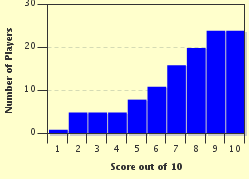Quiz Answer Key and Fun Facts
1. In which stylistic era is Shostakovich's music classified?
2. For which performer did Shostakovich write his first cello concerto?
3. What is the DSCH motif?
4. Where did Shostakovich begin his composition of Symphony No. 7?
5. For which two works was Shostakovich openly condemned in the semi-official Soviet publication Pravda?
6. Which of Shostakovich's symphonies redeemed him in the eyes of the Soviet regime in the aftermath of Pravda's attacks on him?
7. In which of Shostakovich's symphonies is there a chorale with the words:
"October! - the harbinger of the awaited Sun,
October! - the will of the rebel centuries.
October! - labor, joy, and the song.
October! - the happiness of fields and working tables."
8. Shostakovich's symphonic scoring is directly related to that of which Romantic composer?
9. Which of the following operas did Shostakovich NOT write?
10. What country was Shostakovich from?
Source: Author
Portobello
This quiz was reviewed by FunTrivia editor
Bruyere before going online.
Any errors found in FunTrivia content are routinely corrected through our feedback system.


